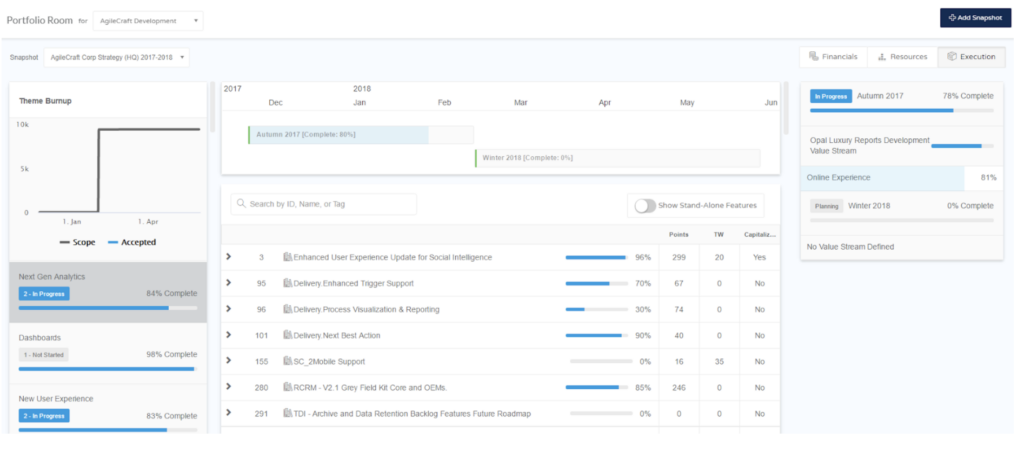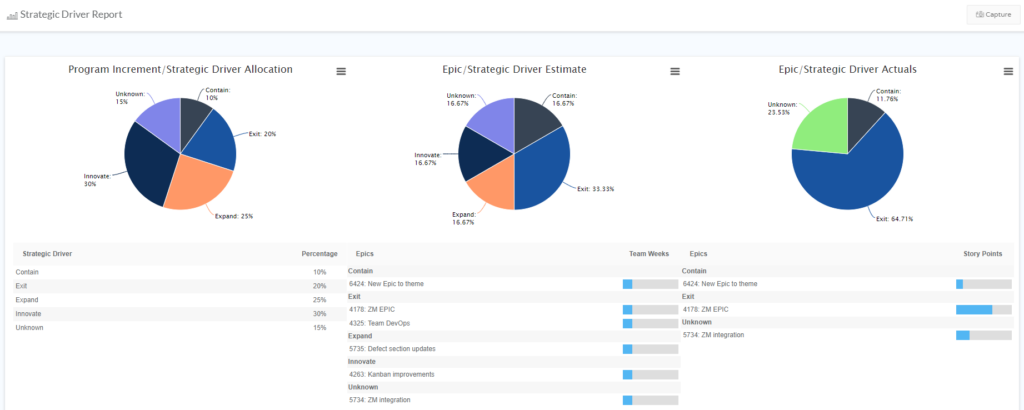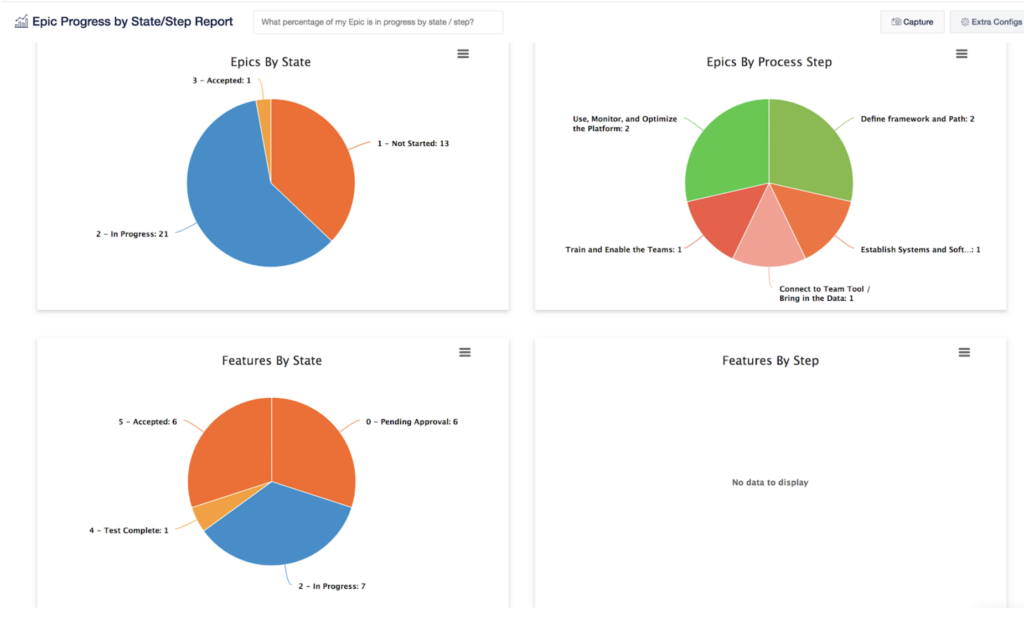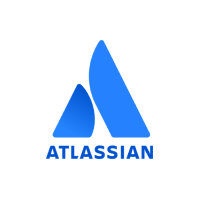The Power of Portfolio Level Reporting in Jira Align (Part 3 of 4)
Please note: This is one in a four-part series on the powerful reporting capabilities offered through Jira Align by Atlassian. The series will cover Jira Align reports of specific value to agile practitioners at the:
- Team Level
- Program Level
- Portfolio Level
- Enterprise Level
Each segment will briefly cover:
- How Jira Align effectively ties each level into the bigger enterprise picture
- Which stakeholders are most likely to use the reports available at each level
- Which Jira Align reports are likely to be most popular at each level and why
Atlassian Jira Align is a cloud-based software specifically designed to effectively scale an organization’s agile practice from the individual development teams to the enterprise level. This offers unmatched visibility into overarching business goals and strategic planning, as well as day-to-day productivity. It unifies every level of the organization so all stakeholders can work from one centralized database.
Successful scaling of agile depends, to a large extent, on that unification. That’s why Jira Align is such an exciting solution to us here at Cprime.
If you’ve never heard of Jira Align, read this primer first, then come back.
How Jira Align Ties The Portfolio Level (Initiatives) Into The Full Enterprise
Part One was focused on the team level, while Part Two discussed the “team of teams” or program level. Moving farther up the pyramid, we come to the portfolio level. If you’ve read the previous articles in this series, you’ll recall these two vital steps in establishing and maintaining agile at scale:
- “The strategic initiatives coming down from the executives must be effectively communicated to — and guide the daily activity of — teams.”
- “Likewise, all the work-based data the teams generate needs to filter up to stakeholders at each level so decisions can be made, steering can be adjusted, and everyone can verify success is being achieved.”
Just as they did at the program level, leaders at the portfolio level need to facilitate that two-way communication to maintain alignment. Jira Align’s reporting capabilities can make that possible.
Which Stakeholders Will Benefit From Portfolio Level Reporting In Jira Align?
Stakeholders at every level benefit from a smooth interchange of information and having access to the best data at all times. However, the roles likely to spend the most time with the specific Portfolio level reports we’ll discuss below include:
- Portfolio Managers
- Executives
- Program Managers (to a lesser degree)
Rather than focusing on individual stories (like a team) or features developed during one planning increment (like a Program Manager), the Portfolio Manager is overseeing an entire solution made up of multiple epics. Each epic is eventually broken down into prioritized features and stories, but the Portfolio Manager doesn’t often get that far into the weeds. Instead, their focus is on understanding the large-scale strategic objectives the organization is pursuing and ensuring the various programs making up their portfolio remain aligned with that vision.
As we look into some specific Portfolio level reports, we’ll consider how Portfolio Managers, especially, can get the most out of them.
Examples of Popular Portfolio Level Reports in Jira Align
Jira Align contains dozens of pre-formatted reports that offer as broad or granular a view as required based on what you need to understand. Custom reporting can be set up as well if specific insights are required that the available reports don’t offer using Atlassian Enterprise Insights or other third-party integrations. (To explore custom reporting in Jira Align, pick up our white paper dedicated to that topic.)
The following are the most popular out-of-the-box reports for effective portfolio management.
Portfolio Room
As noted in the previous section, when discussing the Program Room, the Portfolio Room serves as an optimal “home base” for Portfolio Managers in Jira Align. In this one interconnected set of reports and views, managers will find just about everything they need to carry out their day-to-day tasks, keep their finger on the pulse of the portfolio, and make necessary decisions quickly and confidently:
- Financials – Is the emerging spend aligned with target budgets across the portfolio?
- Resources – Is the emerging scope (down the tree) in line with the higher-level estimates (SWAGs) of effort/size?
- Execution – Is OKR progress tracking against expectations?
With this information, Portfolio Managers can:
- Refine the business strategy and allocate budget to strategic investment themes
- Define and fund value streams
- Identify, prioritize, authorize, and fund epics
- Adjust staffing levels of programs up to three PIs into the future to match the expected demand based on epic backlogs
- Provide governance of execution across the portfolio’s value streams
Strategic Driver Allocation
The Strategic Driver Allocation report allows Portfolio Managers or executives to quickly assess whether the planned strategic allocation of the work is aligned with the work the teams are actually doing or planning on doing. This informs planning and supports alignment top-down from the strategic level with a direct impact on important KPIs including revenue.
The report shows three pie charts that are PI-specific:
- Program Increment/Strategic Driver Allocation – a breakdown of planned allocation for each strategic driver
- Epic/Strategic Driver Estimate – the planned allocation, in team-weeks, based on what has been estimated for every epic associated with the strategic driver
- Epic/Strategic Driver Actuals – a bottom-up calculation reflecting accepted story points from all associated epics within each strategic driver
Additionally, users can view the same information in the form of a list of epics (which is not PI-specific) sorted from most allocation to least.
Reviewing this report regularly will ensure leaders identify any negative trends early and can make the necessary adjustments.
Epic Progress by State Step
Pulling back from the past and future visibility for a moment, the Epic Progress by State report provides a highly visual snapshot of work in progress (WIP) at the portfolio and program levels. Both epics and stand-alone features are broken down by their current state (started, in progress, ready, etc.) and process step (assigned, in development, in review, etc.)
This can quickly and effectively highlight risks and bottlenecks that could be overlooked at the Team level throughout a PI. The chart is especially useful for Portfolio Managers, Program Managers, or RTEs for predicting when WIP will be completed, offering a high-level understanding of whether the work for a PI is on track. Users can filter the report by PI, program, release vehicle, theme group, and Scrum Masters/Product Owners.
Work Tree Reports
The Work Tree reports highlight how Jira Align shines through its unmatched aggregation of data from all levels of the organization. Parent/child relationships are mapped out from the theme level down to individual stories, showing how the progress of each impacts the rest of the organization. WIP updates in near real-time, so adjustments can be made on the fly as needed.
This thorough visibility into the data is priceless for Portfolio Managers who want a comprehensive perspective on all the WIP that falls into their portfolio, progress being made toward established OKRs and strategic initiatives, and what’s already planned for the future. Beyond the apparent benefits for managing WIP, planning ahead, and understanding historic trends, the Work Tree reports also provide Portfolio Managers with quick, accurate, and easily digestible status updates for executives with just a few clicks.
In the last installment of this series, we’ll explore the most popular executive level reports available within Jira Align. If you’d like to learn more about how Jira Align can help your organization, we’d love to hear from you.





